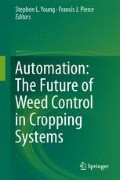Abstract
One of the most important agriculture practices is to properly manage weeds because weeds negatively affect crop yield and quality. There are many types of commercial mechanical weeders that use the three main physical techniques: burying, cutting, and uprooting to controlling weeds. Two categories of mechanical weed control approaches, inter-row and intra-row mechanical weeding, are reviewed and discussed. Specifically, the most commonly used manual inter-row mechanical weeding tools are reviewed and compared according to their working principles. The more challenging area of intra-row mechanical weeding is reviewed, and manually operated intra-row mechanical weed control tools are compared. The current state of the art in automated mechanical weeding is discussed along with some cutting-edge technologies for intra-row mechanical weed control found in industry and the research community.
Access this chapter
Tax calculation will be finalised at checkout
Purchases are for personal use only
References
Alexandrou A (2004) Evaluation of in-row weed cultivators in organic soybeans and corn. Organic Farming Research Foundation, Wooster
Astrand B, Baerveldt A (2002) An agricultural mobile robot with vision-based perception for mechanical weed control. Autonomous Robots 13(1):21–35
Bakker T (2009) An autonomous robot for weed control – design, navigation and control. PhD diss. Wageningen University, Wageningen
Bowman G (1997) Steel in the field: a farmer’s guide to weed management tools, vol 2. Sustainable Agriculture Network, Beltsville, Maryland
Cloutier DC, Weide RY, van der Peruzzi A, Leblanc ML (2007) In: Upadhyaya MK, Blackshaw RE (eds) Mechanical weed management. CAB International, Wallingford, pp 111–134
FG (2008) SarlRadis Hoe. Farmers Guardian. Available at http://www.farmersguardian.com/sarl-radis-hoe/15587.article. Accessed 14 June 2011
Fogelberg F, Gustavsson AD (1999) Mechanical damage to annual weeds and carrots by in-row brush weeding. Weed Res 39(6):469–479
Gianessi LP, Sankula S (2003) The value of herbicides in U.S. crop production. National Center of Food and Agricultural Policy, Washington, DC
Griepentrog H, Norremark M, Nielsen J (2006) Autonomous intra-row rotor weeding based on GPS. CIGR World Congress, Bonn, Germany, p 7. Retrieved from http://www.staff.kvl.dk/~hwg/pdf/papers/Griepentrog2006b.pdf
HCC (2011) Eco weeder. Hillside cultivator company. Available at http://www.hillsidecultivator.com/?page_id=39. Accessed 8 July 2011
Inman JW (2010) Into gear: success of the robocropweeder/thinner. American Vegetable Grower. Available at www.growingproduce.com. Accessed 10 Apr 2010
Kouwenhoven JK (1997) Intra-row mechanical weed control–possibilities and problems. Soil Tillage Res 41:87–104
Melander B (1997) Optimization of the adjustment of a vertical axis rotary brush weeder for intra-row weed control in row crops. J Agric Eng Res 68(1):39–50
Slaughter D, Giles D, Downey D (2008) Autonomous robotic weed control systems: a review. Comput Electron Agric 61(1):63–78. doi:10.1016/j.compag.2007.05.008
Steward BL, Tian LF (1998) Real-time weed detection in outdoor field conditions. In: Meyer GE, DeShazer JA (eds) Proceeding of SPIE 3543, Precision agriculture and biological quality. SPIE, Bellingham, pp 266–278
Tang L, Tian LF, Steward BL (2000) Supervised color image segmentation by genetic algorithm for real-time weed sensing in outdoor lighting conditions. Trans ASAE 43(4):1019–1027
Tillett ND, Hague T, Grundy AC, Dedousis AP (2008) Mechanical within-row weed control for transplanted crops using computer vision. Biosyst Eng 99(2):171–178
Univerco (2011) ECO weeder. Available at http://www.univerco.net/cgi-bin/index.cgi?page=c2_2_0&langue=eng. Accessed 23 June 2011
Van Der Weide RY, Bleeker PO, Achten VTJM, Lotz LAP, Fogelberg F, Melander B (2008) Innovation in mechanical weed control in crop rows. Weed Res 48(3):215–224
Author information
Authors and Affiliations
Corresponding author
Editor information
Editors and Affiliations
Rights and permissions
Copyright information
© 2014 Springer Science+Business Media Dordrecht
About this chapter
Cite this chapter
Ahmad, M.T., Tang, L., Steward, B.L. (2014). Automated Mechanical Weeding. In: Young, S., Pierce, F. (eds) Automation: The Future of Weed Control in Cropping Systems. Springer, Dordrecht. https://doi.org/10.1007/978-94-007-7512-1_7
Download citation
DOI: https://doi.org/10.1007/978-94-007-7512-1_7
Published:
Publisher Name: Springer, Dordrecht
Print ISBN: 978-94-007-7511-4
Online ISBN: 978-94-007-7512-1
eBook Packages: Biomedical and Life SciencesBiomedical and Life Sciences (R0)

